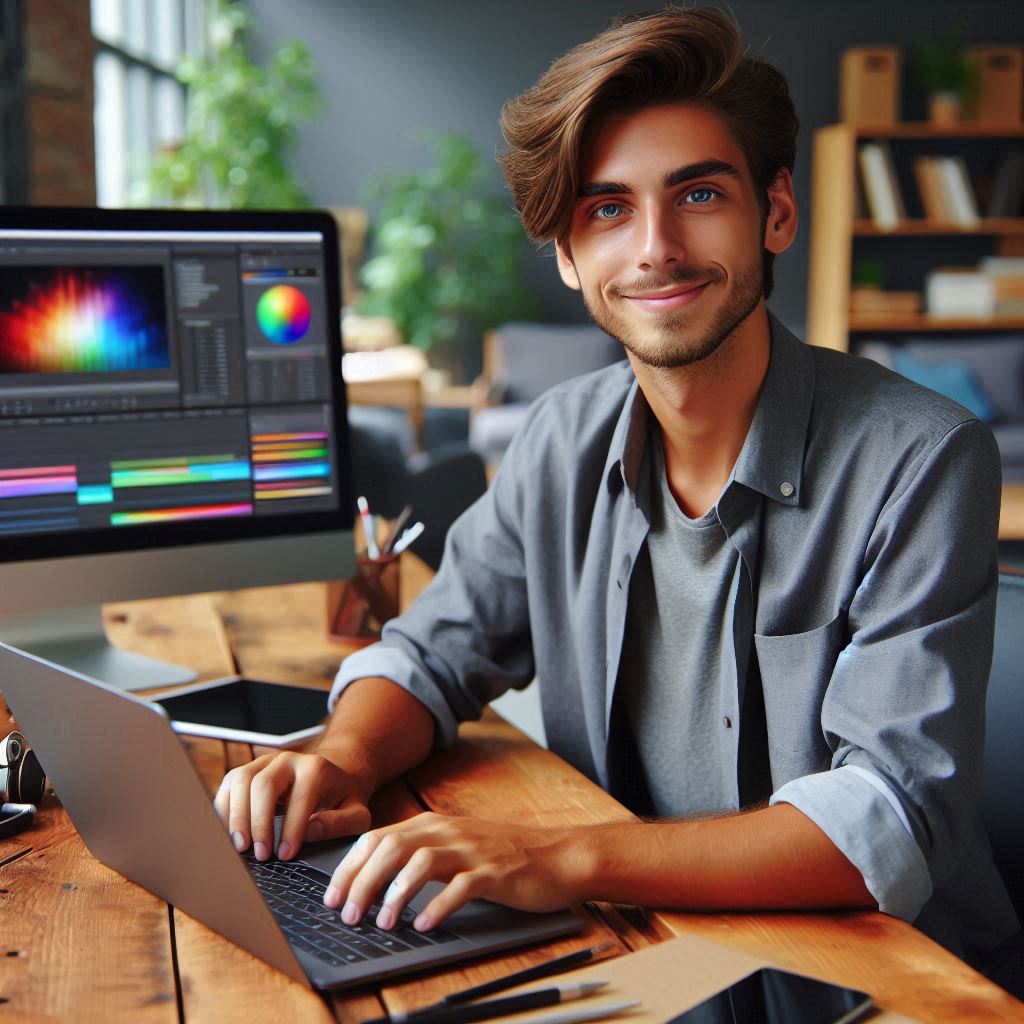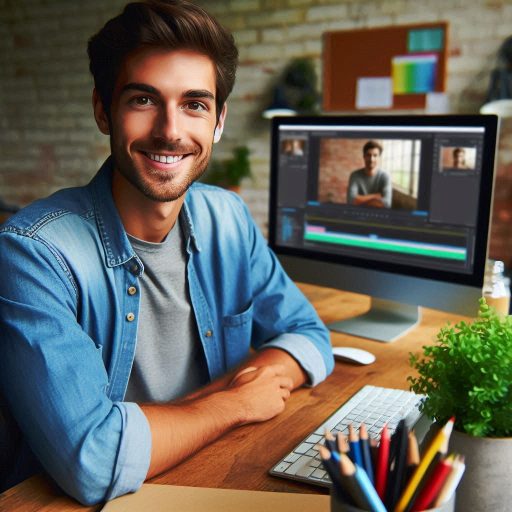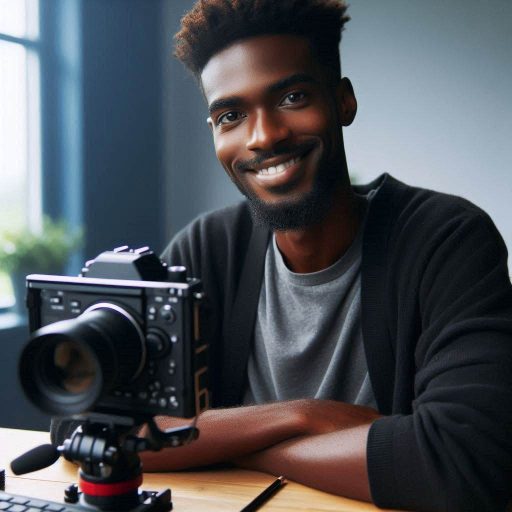Introduction
Multimedia art has come a long way from traditional painting and sculpture.
Multimedia design has expanded to include digital technologies in various forms of art.
This evolution has transformed how artists and designers create and engage with audiences.
In today’s digital age, multimedia plays a crucial role in communication and expression.
Multimedia allows for interactive experiences that engage audiences on multiple levels.
It has become a primary medium for storytelling, advertising, and entertainment in the digital world.
As technology continues to advance, the future of multimedia art and design looks promising.
Virtual reality and augmented reality are expected to revolutionize how we experience art.
Artificial intelligence will also play a significant role in creating personalized and engaging multimedia experiences.
The Rise of Virtual and Augmented Reality in Multimedia
Virtual and augmented reality technologies are revolutionizing the way we experience art and design.
These cutting-edge technologies offer immersive and interactive experiences that go beyond traditional forms of multimedia.
How VR and AR Technologies are Reshaping the Way We Experience Art and Design
Virtual reality (VR) and augmented reality (AR) are opening up new possibilities for artists and designers to create engaging and interactive multimedia projects.
With VR, users can be transported to a virtual world where they can explore art installations, interact with 3D models, and experience narratives in a completely immersive way.
On the other hand, AR overlays digital content onto the real world, allowing for a blend of digital and physical elements in art and design.
Potential Applications of VR and AR in Multimedia Projects
The potential applications of VR and AR in multimedia projects are vast and diverse.
In the realm of art, VR can be used to create virtual galleries where users can view and interact with artworks from around the world.
AR, on the other hand, can be used to enhance traditional art forms by adding digital elements, such as animations and sound effects, to physical artworks.
In the field of design, VR and AR can be used to visualize architectural designs, prototype products, and create immersive brand experiences.
Advantages and Challenges of Incorporating VR and AR in Multimedia Art and Design
There are several advantages to incorporating VR and AR in multimedia art and design projects.
One of the main advantages is the ability to create immersive and interactive experiences that engage audiences in new and exciting ways.
Transform Your Career Today
Unlock a personalized career strategy that drives real results. Get tailored advice and a roadmap designed just for you.
Start NowVR and AR also offer artists and designers new tools and techniques for creating innovative multimedia projects.
However, there are also challenges to consider when working with VR and AR technologies.
These challenges include the technical complexity of creating VR and AR experiences, the need for specialized hardware and software, and the potential for motion sickness and other discomforts for some users.
In essence, virtual and augmented reality technologies are transforming the landscape of multimedia art and design.
By exploring the potential applications, advantages, and challenges of VR and AR, artists and designers can harness the power of these technologies to create truly unique and immersive multimedia experiences for audiences around the world.
Read: From Concept to Creation: Multimedia Art Workflow
Integration of artificial intelligence in multimedia creation
Artificial intelligence (AI) is revolutionizing the field of multimedia art and design by providing innovative tools and techniques that enhance creativity and efficiency in the creation process.
How AI algorithms are being used to enhance creativity in multimedia projects
- AI algorithms can analyze data and patterns to generate personalized recommendations for multimedia artists.
- AI-powered tools can automate repetitive tasks, allowing artists to focus on more creative aspects of their work.
- AI can be used to enhance the visual effects in multimedia projects, creating stunning and realistic graphics.
- AI algorithms can help artists experiment with different styles and techniques, pushing the boundaries of traditional multimedia design.
Examples of AI-driven tools and software for multimedia artists and designers
- Adobe Sensei: Adobe’s AI technology that powers various features in its Creative Cloud applications, such as content-aware fill and automated image tagging.
- Runway: A platform that allows artists to experiment with AI-generated tools and effects to enhance their multimedia projects.
- DeepDream: A neural network algorithm developed by Google that creates hallucinatory and dream-like images based on input images.
- Prisma: An AI-powered app that turns photos into artworks using the styles of famous artists and artwork.
Ethics and implications of AI in the future of multimedia art and design
Concerns about AI taking over jobs in the creative industry and replacing human creativity with artificial intelligence.
Issues surrounding data privacy and ownership when using AI-powered tools that analyze and manipulate user-generated content.
Debates about the authenticity and originality of artworks created with AI assistance and the role of the artist in the creative process.
The need for regulations and guidelines to ensure ethical use of AI in multimedia creation and protect the rights of artists and creators.
In fact, the integration of artificial intelligence in multimedia art and design offers exciting opportunities for artists to explore new creative possibilities and streamline their workflow.
However, it is essential to consider the ethical implications and potential challenges that AI brings to the future of multimedia creation.
Read: Industry Tools Every Multimedia Artist Should Know
Sustainable practices in multimedia art and design
As the world becomes more conscious of environmental issues, the role of sustainable practices in multimedia art and design is gaining importance.
Artists and designers are now looking for ways to reduce their environmental impact while still creating impactful and innovative work.
Here are some key aspects of sustainable practices in multimedia art and design:
Importance of eco-friendly materials and techniques in multimedia projects
- Using recycled materials: Many multimedia artists and designers are opting for recycled materials in their projects to reduce waste and carbon footprint.
- Low-impact production processes: Choosing production techniques that have minimal environmental impact, such as digital printing over traditional methods.
- Biodegradable materials: Exploring materials that are biodegradable or compostable to ensure that the artwork does not contribute to landfill waste.
- Energy-efficient practices: Implementing energy-efficient lighting and equipment in studios to reduce energy consumption.
Trends in sustainable design and production processes
- Collaboration with eco-friendly brands: Many multimedia artists and designers are collaborating with sustainable brands to create environmentally conscious projects.
- Upcycling and repurposing: Giving new life to old materials by upcycling and repurposing them in multimedia projects.
- Minimalism and simplicity: Embracing minimalist design principles to create visually striking artwork with a smaller environmental footprint.
- Virtual exhibitions: Hosting virtual exhibitions to reduce the carbon footprint associated with physical events.
Role of multimedia artists and designers in promoting environmental awareness through their work
- Educating the audience: Through their artwork, multimedia artists and designers can educate the audience about environmental issues and the importance of sustainable practices.
- Inspiring change: By showcasing innovative and sustainable design solutions, artists and designers can inspire others to adopt eco-friendly practices in their own work.
- Advocacy through art: Using art as a platform to advocate for environmental causes and raise awareness about pressing environmental issues.
- Community engagement: Collaborating with local communities and organizations to create environmentally focused projects that benefit the community as a whole.
Read: How to Network in the Costume Design Industry

Collaboration and Interdisciplinary Approaches in Multimedia Creation
In the ever-evolving landscape of multimedia art and design, collaboration and interdisciplinary approaches play a crucial role in pushing the boundaries of creativity and innovation.
By bringing together individuals from different backgrounds and expertise, multimedia projects can benefit in various ways.
Transform Your Career Today
Unlock a personalized career strategy that drives real results. Get tailored advice and a roadmap designed just for you.
Start NowBenefits of Cross-Disciplinary Collaborations in Multimedia Projects
- Enhanced Creativity: Collaboration allows for the exchange of ideas between diverse perspectives, leading to innovative solutions and creative outcomes.
- Expanded Expertise: By working with experts from various fields, multimedia projects can leverage a wide range of skills and knowledge.
- Efficient Problem-Solving: Different professionals bring unique problem-solving approaches, resulting in more effective solutions to complex challenges.
- Diversified Perspectives: Collaboration fosters a rich tapestry of viewpoints, enriching the creative process and enhancing the overall quality of the project.
- Networking Opportunities: Collaborating with professionals from different disciplines can open doors to new connections and future opportunities.
Examples of Successful Partnerships Between Artists, Designers, Technologists, and Scientists
Several noteworthy collaborations in multimedia projects have demonstrated the power of cross-disciplinary partnerships:
- The “Bj‘rk Digital” project, which combined the talents of musicians, visual artists, and technologists to create an immersive virtual reality experience.
- The collaboration between architect Zaha Hadid and digital artist Algorithmic Art to design a stunning 3D-printed dress for the fashion industry.
- The partnership between neuroscientists and multimedia designers to develop interactive installations that explore the intersection of art and brain science.
- The merging of fashion designers, engineers, and coders to create wearable technology that fuses fashion and innovation seamlessly.
Future Trends in Collaborative Multimedia Art and Design Projects
As technology continues to advance and creative boundaries are pushed further, the future of collaborative multimedia art and design projects looks promising.
Some emerging trends to watch out for include:
- Virtual Reality and Augmented Reality Integration: Collaborations between artists and technologists to create immersive experiences that blend the real and virtual worlds seamlessly.
- Artificial Intelligence in Creative Processes: Partnerships between designers and AI experts to explore the use of machine learning algorithms in generating art and design concepts.
- Interactive Installations and Experiential Design: Collaborations that focus on creating engaging multimedia installations that invite audience participation and interaction.
- Sustainability and Environmental Consciousness: Partnerships that prioritize eco-friendly practices and materials in multimedia projects to promote environmental awareness and responsibility.
- Cross-Cultural Collaborations: Artists and designers from diverse cultural backgrounds coming together to create multimedia projects that celebrate global perspectives and diversity.
In short, collaboration and interdisciplinary approaches are essential in shaping the future of multimedia art and design.
By embracing diverse perspectives and expertise, multimedia projects can continue to innovate, inspire, and captivate audiences in the years to come.
Read: Successful Multimedia Artists to Follow in 2024
See Related Content: Essential Reading for Industrial Design Students
Personalization and Interactive Storytelling in Multimedia
In the dynamic landscape of multimedia art and design, personalization and interactive storytelling play vital roles in shaping the future of creative projects.
Let’s delve into how personalized experiences are influencing the field and the advancements in interactive storytelling techniques that are redefining multimedia content.
How Personalized Experiences are Shaping the Future of Multimedia Art and Design
- Customization: Users now expect personalized content tailored to their preferences and interests.
- Data-driven Design: Analyzing user data helps in creating personalized experiences in multimedia projects.
- Enhanced User Engagement: Personalization leads to increased user engagement and satisfaction.
- Targeted Marketing: Personalized multimedia content enables targeted marketing strategies for better reach.
- Brand Loyalty: Personalization fosters brand loyalty as users feel a stronger connection to the content.
Advancements in Interactive Storytelling Techniques in Multimedia Projects
- Immersive Experiences: AR and VR technologies enhance interactive storytelling in multimedia art.
- Non-linear Narratives: Interactive storytelling allows users to choose their own paths in the narrative.
- Feedback Mechanisms: Real-time feedback loops enable interactive elements in multimedia projects.
- Gamification: Gamified storytelling techniques engage users and make the content more interactive.
- Dynamic Content: Content that adapts based on user interactions creates a more personalized experience.
The Role of User Engagement and Participation in the Creation of Multimedia Content
- Co-creation: Involving users in the content creation process enhances user experience and satisfaction.
- Social Sharing: Interactive elements encourage users to share multimedia content on social platforms.
- User Feedback: Gathering user feedback helps in refining and improving multimedia projects.
- Community Building: Interactive storytelling fosters a sense of community among users who engage with the content.
- User-Centric Design: Putting users at the center of the design process ensures the creation of impactful multimedia content.
As technology continues to evolve, personalization and interactive storytelling will continue to play crucial roles in the future of multimedia art and design.
Embracing these advancements can lead to more engaging and immersive experiences for users across various platforms.
Cultural Diversity and Inclusivity in Multimedia Art and Design
When it comes to multimedia art and design, cultural diversity and inclusivity are crucial aspects that play a significant role in shaping the future of the industry.
In this section, we will explore the importance of representing diverse voices and perspectives in multimedia projects, current trends in promoting cultural diversity and inclusivity, as well as the challenges and opportunities for multicultural exchange in the future of multimedia art and design.
Importance of Representing Diverse Voices and Perspectives in Multimedia Projects
- Enhances creativity and innovation by incorporating varied viewpoints.
- Reflects the complexity of human experiences and identities.
- Connects with diverse audiences on a deeper level.
- Fosters empathy and understanding among different cultural groups.
- Breaks stereotypes and challenges societal norms through artistic expression.
Trends in Promoting Cultural Diversity and Inclusivity through Multimedia
- Collaborations with artists from different cultural backgrounds.
- Utilization of indigenous art forms and storytelling techniques.
- Integration of multicultural themes in mainstream media platforms.
- Virtual reality experiences that immerse viewers in diverse cultures.
- Interactive installations that encourage cross-cultural dialogue.
Challenges and Opportunities for Multicultural Exchange in the Future of Multimedia Art and Design
- Language barriers can impede effective communication in global projects.
- Cultural appropriation versus cultural appreciation debates may arise.
- Lack of representation of marginalized communities in multimedia content.
- Opportunity to create impactful social change through inclusive storytelling.
- Potential for cross-cultural collaborations to inspire new artistic movements.
Overall, the future of multimedia art and design holds immense potential for promoting cultural diversity and inclusivity.
Artists and designers embrace diverse cultures to create meaningful experiences.
They celebrate cultural richness to craft impactful global connections.
This approach helps them resonate with audiences worldwide.
Through diversity, they foster deep and lasting engagement.
Conclusion
The future of multimedia art and design is incredibly promising.
We have discussed the impact of technology, interactivity, and immersive experiences in shaping this field.
Transform Your Career Today
Unlock a personalized career strategy that drives real results. Get tailored advice and a roadmap designed just for you.
Start NowThe potential of multimedia art and design in revolutionizing the creative industries cannot be understated.
The blend of different media forms offers endless possibilities for expression and communication.
As we move forward, it is important for creators and designers to continue pushing the boundaries of what is possible in multimedia art and design.
By experimenting with new technologies and platforms, we can unlock even more innovative and impactful ways to tell stories and engage audiences.
The future of multimedia art and design is bright, and the opportunities for growth and innovation are limitless.
By staying curious, adaptable, and collaborative, we can continue to shape the way we experience and interact with art and design.
I encourage all readers to explore and contribute to the evolving landscape of multimedia art and design.
Whether you are a creator, a consumer, or simply an enthusiast, your perspective and engagement are essential in driving the future of this dynamic and exciting field.




